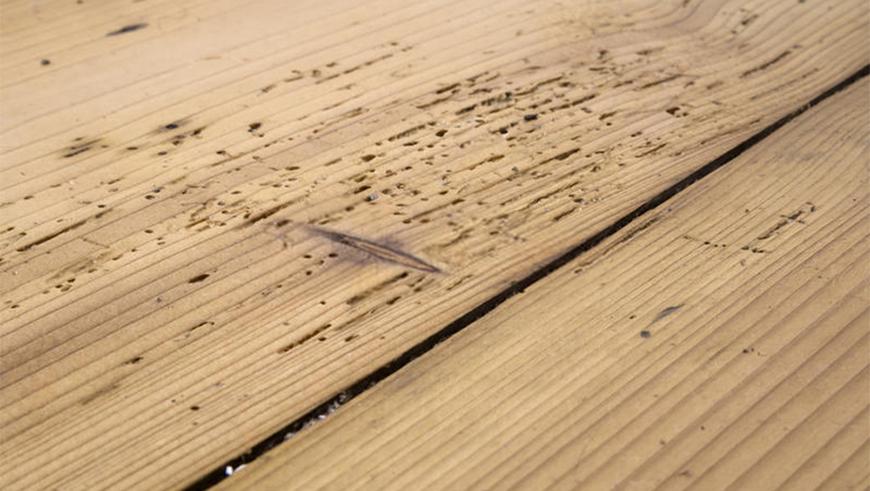Woodworm Treatment Cost
Last updated 4th June, 2025
Wondering how to treat woodworm?
In this article you'll discover everything about wood worm treatment. We discuss types of wood worms, woodworm treatment spray, how to find a woodworm specialist and more!
Continue for more...

Table of Contents
How Much Does Woodworm Treatment Cost?
The average material cost will vary depending on the woodworm treatment you buy. Prices start from £5 to £20 depending on how much you need and can easily be picked up from a local DIY shop or online.
The average specialist will usually charge around £100 to £150 per day depending on location. Depending on the severity of the woodworm, the specialist should not take more than a few hours to treat the woodworm, but may have to continously treat the affected areas to ensure the woodworm is eradicated.
Below are some estimated costs of hiring a specialist to treat woodworm:
| Job Description | Avg. Cost | Duration |
|---|---|---|
| Treat your home for all stages of woodworm | £500-£800 | 1-3 days |
| Woodworm survey | £80-£200 | 2-4 hours |
| Treat furniture for woodworm | £70-£150 | 1 day |
Woodworm Treatment Cost Breakdown Calculator
Individual costs to treat your home for all stages of woodworm: £500
Materials
£100
Tradesmen
£400
Waste Removal
£0
What is Woodworm?
Woodworm is the larvae of wood-boring beetles, of which there are several different species in the UK. But the most damage is caused by the Common Furniture beetle larvae.
The main damage caused by woodworm can be tricky to spot initially as this damage is inside the timber, so you are unlikely to see any visible damage for some time, possibly even years after infestation. However, there are some signs that can help to identify an infestation, the most obvious being small holes in your woodwork and fine dust around these holes.
Woodworm can be found on all wood surfaces including of course roof beams, floorboards and rafters, but also in furniture. The amount of damage caused by woodworm depends on the species, the size or duration of the infestation, and the timber that has been infested.
Some species of woodworm are not particularly harmful, whereas others can seriously weaken timber and cause structural damage. Identifying the woodworm species is definitely a job best left to a professional.
Additional Costs for Woodworm Treatment
Following any initial assessments and woodorm treatment, there can be a varity of additional costs as a result. The price of which can depend on the severity of the issue and the extent of the damage.
As such, the labour costs will also be affected by the length of time the work required. Although the following helps give you an idea of additional costs that may be encountered:
Floor Repairs
Once the woodworm issue has been addressed, the cost of restoring wood flooring will depend if you require a simple staining (£4 to £8 per m²) or sanding and refinishing (from £25 to £35 per m²).
In the event of a more severe infestation, you may need to replace individual floorboards and joists (costing on average £200 to £300) or in drastic situations the whole of the wooden flooring (ranging from £350 to £2,700 depending on style and size of room).
Damp Treatment
Woodworm infestations often thrive in damp conditions and as such, treating the underlying damp issue is crucial to stop it from re-occuring.
As for the costs involved, this depends on if you are treating rising damp with a definitive course of damp proofing (on average costing £2,750) or targetting specific areas such as a basement (£125 per m²).
Structural Repairs
In cases where woodworm has caused significant damage to structural elements, such as internal walls or supporting beams, the cost to fix the issue is hard to estimate without a full assessment.
Before calling in a builder, it's a good idea to hire an experienced structural engineer to review the situation. They will normally charge at an hourly rate, so it's a good idea to budget around £90 or slightly more if you live in a larger property or areas such as London or the South East.
Fumigation or Fogging Treatment
In extreme case, it may be required to hire a professional to fumigate your entire home. This is done by sealing the property and releasing a gas that can penetrate the timber while you're temporarily staying elsewhere.
Meanwhile, fogging involves spraying insecticide into the air, killing any larvae and beetles in those hard-to-reach areas.
This treatment process cost between £500 and £3,000 depending on the property's size and the infestation's severity.
Treatment and Prevention of Woodworm
Most modern woodworm treatments involve using odourless chemicals that can effectively kill wood eating insects of all types. These can be used on furniture, floorboards, structural timbers and roof rafters, and offer a good penetration into the wood itself.
For best results:
- Treat all affected areas thoroughly, cleaning and spraying according to the product being used
- For a deeper infestation, inject treatment into any holes already created as a result of woodworm
- In the event of more serious issues, you may have to drill into the wood yourself prior to treatment
It is essential to contact a specialist in the first instance to correctly identify the type of woodworm you are dealing with. Then if the woodworm only affects small, non-structural items, you can easily treat it yourself using "over the counter" woodworm treatment.
Although it can be difficult to completely prevent woodworm, you can definitely make things more difficult for them by taking the following precautions:
- Paint and/or varnish any unaffected wood in the property to prevent further infestation problems
- Keep your home warm and well ventilated, as well as monitoring any damp or moisture levels
- replace any infected timbers as soon as possible, and ensure new timber is kept dry
Failure to completely deal with a woodworm problem by cutting corners will end up costing you much more in the long run. A common mistake is to simply brush on an over the counter treatment on the areas which are visibly affected by woodworm.
However, you should always consult an expert to identify both the type and extent of the infestation, removing severely damaged timbers and carefully treating everything else - half measures are no good!
DIY Treatment vs Professional Treatment
With the right level of experience and correct over-the-counter products, surface-level issues are fine to tackle as a DIY job, although if you're unsuccessful you may still need to call in the professionals.
DIY Woodworm Treatment
Pros
- ✔ Cost-effective: Shop-bought treatments are relatively cheap and easy to obtain
- ✔ No labour costs: As with any DIY project, you automatically save on labour costs
- ✔ Ideal for minor issues: Suitable for smaller problems, such as furniture or isolated instances
Cons
- ✖ Less experience: You could use the wrong treatment, or be unaware of a bigger issue
- ✖ Limited reach: DIY sprays and brushes won't be enough for deeper infestations
- ✖ May not be suitable: For example with structural damage, DIY treatment is unlikely to resolve the problem
Professional Woodworm Treatment
Pros
- ✔ Correct identification: Professionals can accurately diagnose the species and extent of infestation
- ✔ Longer-lasting results: With specialist treatments, you're less likely to see the woodworm return
- ✔ Recommended for structural damage: Can assess and act on larger issues that are more serious to deal with
Cons
- ✖ More expensive: The cost of labour, equipment and expertise comes at a higher price than doing it yourself
- ✖ Temporary relocation: Depending on the extent of the treatment, residents may need to vacate the property
- ✖ Waiting time: You will need to book an assessment, along with arranging a follow-up appointment for the work
In conclusion, DIY is fine for small, non-structural issues such as treating woodworm in furniture or localised areas.
However, for anything more serious or you need an expert opinion, then a professional can provide expert advice along with attending to the issue thoroughly.








